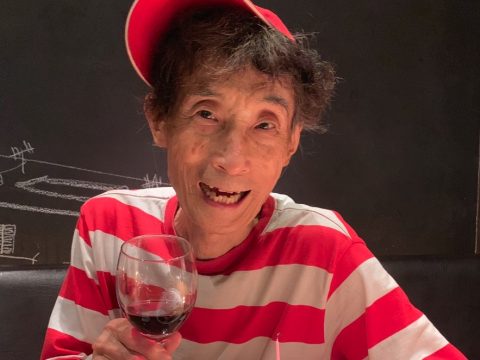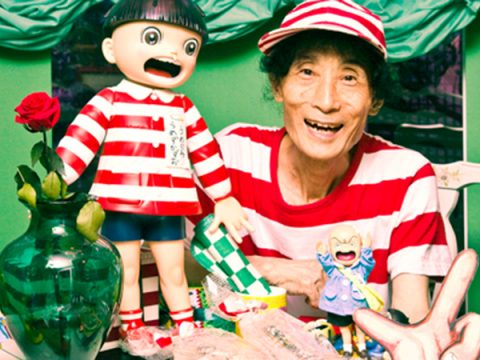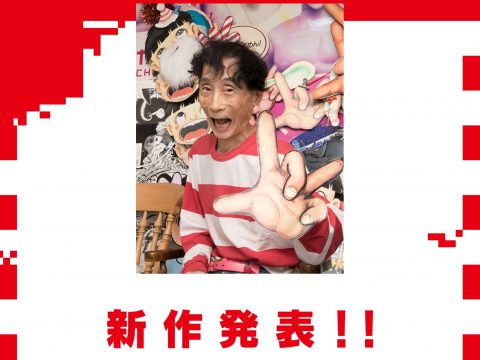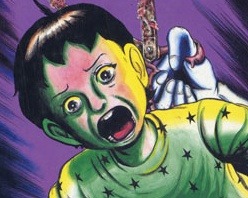Ah, there goes that ageless, fey creature again—known by some as legendary mangaka Kazuo Umezu, or even just Umezz to those “in the know”—zipping quietly through the streets in an effort to return to his striped abode unseen; a portent of good fortune. It would be a mighty feat to ring in Halloween without the man’s work, and I can’t in good conscience recommend that anyone do so. But what horrors could come from such a man, one that looks no different today than he did when meeting legendary Italian director Dario Argento in 1994… or any time before for that matter.
It’s been exactly two years since I last had the chance to talk about his horrors-of-the-wasteland epic, The Drifting Classroom, so it feels right to release the barricades on those double doors once more. Viz wrapped up their Signature release of the series in April of 2008, bringing the 11-volume tale originally serialized in Shonen Sunday from 1972-1974 to a frightful close. With the series still sitting on the shelves of some bookstores and comic shops, it’s a good time to plunk down on the whole shebang and set the properly spooky atmosphere for a moonlit marathon read.
Kazuo Umezu has plenty of appetizers out there for newcomers to his world—individual stories or anthologies that may serve as a less intimidating introduction—but this right here is the main course. It isn’t until one really stands back from it and looks at the work as a whole that the scope of it all becomes truly impressive. The cast alone is loaded with students across different grade levels, all uniquely affected by the strange events that land their school in a soul-crushing desert expanse. Like any good teacher calling roll in the morning, Umezu doesn’t forget about a single one.
The dilemma presented is as much “how did we get here?” as it is “how do we get back?”. It’s bad enough that all of these kids are now separated from their families by an indeterminate gulf—spacial, temporal, or maybe all of the above—but they now have to deal with the unpredictable nature of a cornered and desperate man in the form of the faculty present, as well as the ever-changing dynamic of the student body in crisis. The Drifting Classroom has been compared to Lord of the Flies many, many times, and for good reason.
Only those kids had it easy. They never had to deal with colossal desert monsters, strange cults, or the black plague, to scratch the surface lightly.
Sho Takamatsu is the perfect protagonist for the series, presenting a relatively level-headed look at their situation despite ever-worsening odds. When one of the aforementioned monsters attacks the school, he comes up with the double-whammy solution of chloroform to knock out the littlest of kids, while the rest are told to pretend they’re chairs, waiting in frozen silence, hoping their ruse will deter the monster, at least for the time being.
Most interesting, though, is the cross-dimension connection Sho holds with his mother. Maybe it comes about as a manifestation of the guilt he feels for the way he last spoke to her, or maybe their connection to one another really is that strong. Either way it presents a fantastic device, allowing her to manipulate certain objects in the past in ways that can assist them in whatever branch of our future they may currently reside. The best example of this comes when Sho’s mother has to find a mummified corpse in which she plans to place a very crucial object, and… what happens is really best left to be discovered in context.
Like most of Umezu’s work, there’s a very real fear behind the events of The Drifting Classroom. It’s written like something that even frightens Umezu to his core, because, well, it probably does. Hell, the idea that an elementary school vanishes one day and is zapped right into what appears to be our own desolate fate as humans is enough of a ghoulish thought on its own, but he’s constantly throwing new threats at the reader, both physical and psychological, with the obvious overlaps between the two that keep the big question alive: is all of this real, or have portions been fabricated by the fried minds of traumatized children?
Whether that question is still alive by the time the story wraps is up to the individual, I suppose, but Umezu presents the events of the manga, no matter how over-the-top insane something may be, in a completely straightforward manner. Classroom can be funny at times; it can be completely ridiculous and, make no mistake, it revels in it. But what it doesn’t do is make a joke out of the events that transpire. Forgive me if this spoils a little something, but here’s a perfect example. At one point rain finally comes, but like everything else in the story there is a catch. As a result, a crushing flood rushes the school, so some of the students—the sweet, innocent elementary school girls, to be specific—create a human barricade at the front gate, hoping to momentarily stave off the disaster.
And when the water hits, heads pop like dandelions.
That’s just one very small portion of the saga; a grain of sand in terror-filled dunes. Saying anything is almost saying too much, but these tidbits should certainly pique the interest of the morbid minded. 11 volumes may seem like a large investment, and if gathered all at once, it can also be a pricy one. I assure everyone, though, that this series is absolutely top of the line both within and outside of its genre. Being able to look at the whole series in retrospect just makes me want to crack open volume one and start all over again. Hey, like the Geto Boys said, “this year Halloween fell on a weekend.” Looks like I may have time after all.
HYORYU KYOSHITSU © Kazuo UMEZU/Shogakukan






